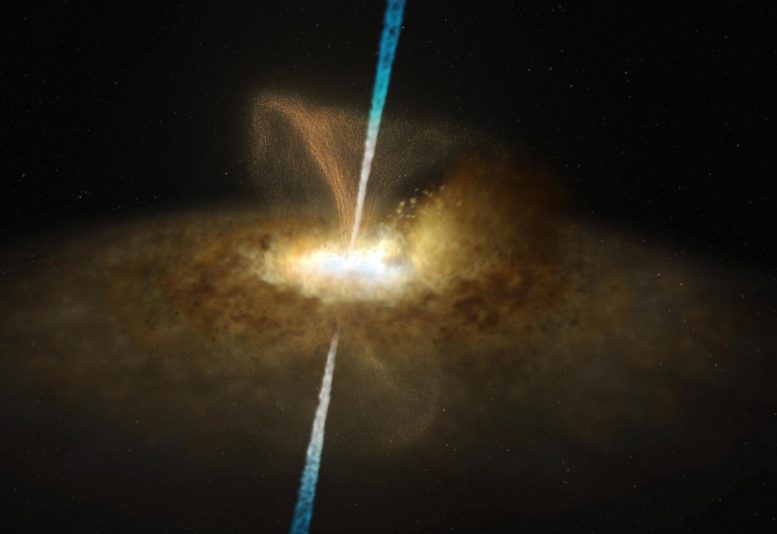
This illustration shows what the core of Messier 77 might look like. As other active galactic nuclei, the central region of Messier 77 is powered by a black hole that is surrounded by a thin accretion disc, which itself is surrounded by a thick ring or torus of gas and dust. In the case of Messier 77, this thick ring completely obscures our view of the supermassive black hole.
This active galactic nucleus is also believed to have jets, as well as dusty winds, that flow out of the region around the black hole perpendicularly to the accretion disc around it.
Credit: ESO/M. Kornmesser and L. Calçada
An international team of astronomers led by Violeta Gámez Rosas (Leiden University) has observed a supermassive black hole hidden in a ring of dust. This discovery fits the idea that the so-called active centers of galaxies are much more similar than observations show, because the viewing angle from Earth causes distortions. The research was done with the MATISSE instrument, co-developed in the Netherlands, which combines infrared light from four European Very Large Telescopes (VLT) in Chile.
Active galactic nuclei (AGNs) are extremely energetic sources powered by supermassive black holes. This short video provides insights into these peculiar objects by showcasing a new discovery on the AGN at the center of the Messier 77 galaxy. Credit: ESO
MATISSE is the acronym for Multi AperTure mid-Infrared SpectroScopic Experiment. MATISSE not only couples the light from the VLT, but also analyzes it. MATISSE was created specifically for infrared light with wavelengths between 3 micrometers and 13 micrometers. Infrared light is also created when something gives off heat. Therefore, MATISSE is cooled to minus 241 degrees Celsius so the instrument itself does not interfere with the measurements.
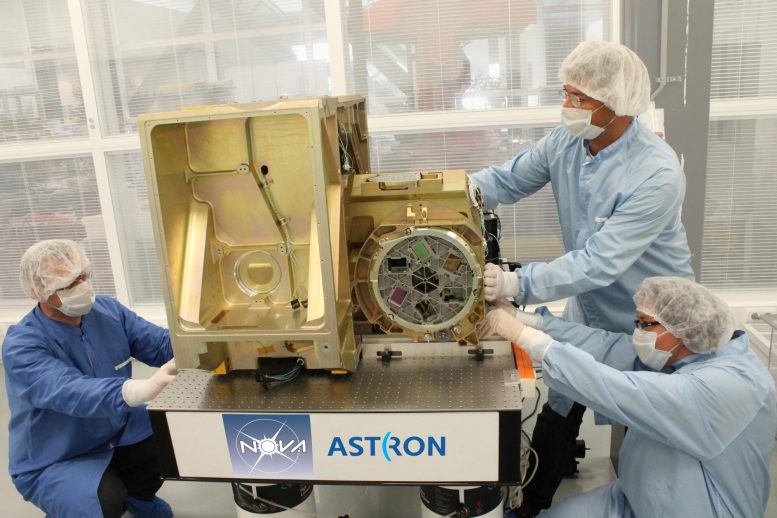
The MATISSE instrument when it was built at NOVA and had not yet been installed in Chile at the VLT. Credit: NOVA
Nanometer precision
Netherlands Research School for Astronomy (NOVA) built all the lenses and mirrors in the cooled part of MATISSE together with the Dutch space industry. The Netherlands had gained experience while developing its forerunner MIDI, which could link two telescopes instead of four.
The heart where the beams of the four VLT telescopes converge, consists of two aluminum boxes that are almost a meter in size. These boxes are filled to the brim with hundreds of optical components, dozens of sensors, and dozens of tiny motors. Most of the components work with nanometer precision or even higher.
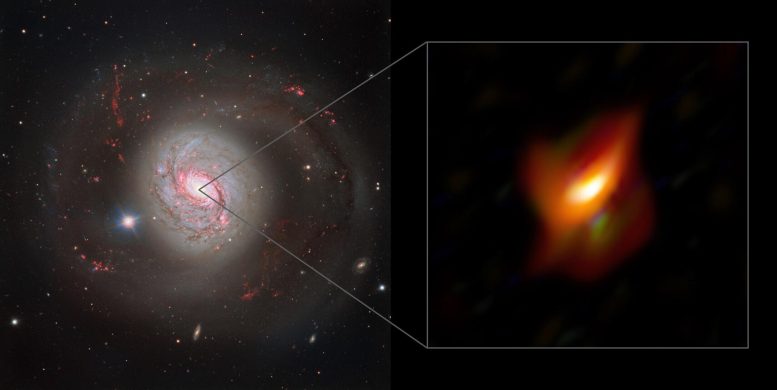
The left panel of this image shows a dazzling view of the active galaxy Messier 77 captured with the FOcal Reducer and low dispersion Spectrograph 2 (FORS2) instrument on ESO’s Very Large Telescope. The right panel shows a blow-up view of the very inner region of this galaxy, its active galactic nucleus, as seen with the MATISSE instrument on ESO’s Very Large Telescope Interferometer. Credit: ESO/Jaffe, Gámez-Rosas et al.
For more on this discovery, see Supermassive Black Hole Caught Hiding in an Immense Ring of Cosmic Dust.
Reference: “Thermal imaging of dust hiding the black hole in the Active Galaxy NGC 1068”by Violeta Gámez Rosas, Jacob W. Isbell, Walter Jaffe, Romain G. Petrov, James H. Leftley, Karl-Heinz Hofmann, Florentin Millour, Leonard Burtscher, Klaus Meisenheimer, Anthony Meilland, Laurens B. F. M. Waters, Bruno Lopez, Stéphane Lagarde, Gerd Weigelt, Philippe Berio, Fatme Allouche, Sylvie Robbe-Dubois, Pierre Cruzalèbes, Felix Bettonvil, Thomas Henning, Jean-Charles Augereau, Pierre Antonelli, Udo Beckmann, Roy van Boekel, Philippe Bendjoya, William C. Danchi, Carsten Dominik, Julien Drevon, Jack F. Gallimore, Uwe Graser, Matthias Heininger, Vincent Hocdé, Michiel Hogerheijde, Josef Hron, Caterina M. V. Impellizzeri, Lucia Klarmann, Elena Kokoulina, Lucas Labadie, Michael Lehmitz, Alexis Matter, Claudia Paladini, Eric Pantin, Jörg-Uwe Pott, Dieter Schertl, Anthony Soulain, Philippe Stee, Konrad Tristram, Jozsef Varga, Julien Woillez, Sebastian Wolf, Gideon Yoffe and Gerard Zins, 16 February 2022, Nature.
DOI: 10.1038/s41586-021-04311-7




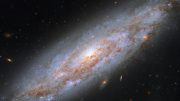


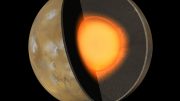

Rotation,of milkyway relative to all other galaxies has a parameter of orientation.Likely,all other galaxies;each of them has own rotation with relative to all other galaxies,added by an orientation of self.Thus for this parameter of orientation,of galaxy rotation,observation from earth to the galaxy is obstaculated.So we can measure the rotation of milkyway accurately,due to presence of specific parameter or property of orientation.
In other galaxis with AGN,plsma around the super massive black hole have each a specific orientation due to rotation with respect to all other galaxies respectively.So,this obstacles view from the earth.Simultaneously milkyway has own rotation with an orientation property.